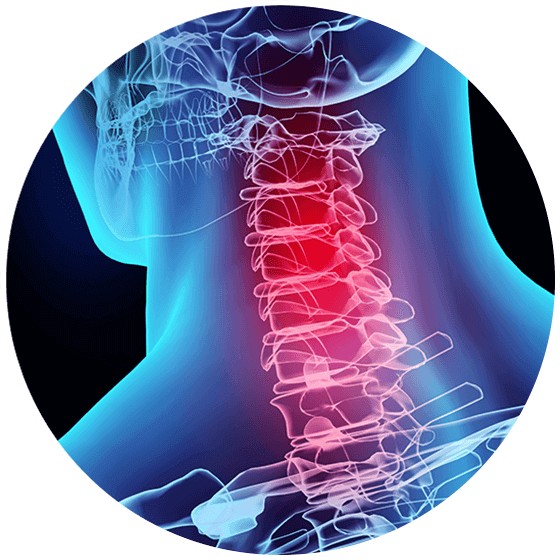Whiplash

Whiplash Symptoms & Treatment Options
Whenever the term whiplash comes up, we are talking about an injury to the cervical spine. The cervical spine, or the neck, is the most flexible section of vertebrae in the spine. Our cervical spine allows us to turn our head up and down, side to side, and so on. It helps us to know what’s going on around us by turning our eyes and ears in the direction of sights and sounds. Unfortunately, because our neck has so much mobility, it is also more susceptible to injuries, including whiplash.
Whiplash, a type of neck sprain or strain depending on the severity of the injury, is the non-medical term for a category of sudden movement neck injuries. Whiplash occurs when a traumatic event causes the neck to quickly jerk in an uncontrolled manner. Sudden movement injuries can cause strain to the muscles, ligaments, and nerves that support our cervical spine. For example, think of the quick jerking of the neck in a rear-end collision car accident.
Common Causes of Whiplash
Although it is sometimes thought that whiplash occurs only with jerky head movements to the front and back, side-to-side movements can also cause whiplash. This rapid movement can result in minor to major damage to the structures in our neck. Neck strain involves the tearing or damage of muscles that connect to the bones of our cervical spine, whereas neck sprain is the result of damage to ligaments that hold our vertebrae together. Although technically strain and sprain are categorically different, signs and symptoms are often similar.
While we most often associate car crashes with whiplash, this is not the only circumstance that can lead to whiplash. Any incident in which the head and neck move rapidly in any direction can lead to this uncomfortable and troubling condition. Events such as falls, sports injuries like football tackles and skiing accidents, bungee jumping, head-banging, and roller coasters are just some of the ways in which whiplash can occur. Regardless of how the damage occurs, however, the signs and symptoms can be quite troubling and uncomfortable. For neck injuries that don’t heal within 2-3 days, bring your injury to the attention of a physician. A medical professional can rule out more serious forms of damage to your spine.
If you have experienced anything that caused your head or neck to jerk uncontrollably back and forth, keep a watchful eye out for the following symptoms:
Pain in the neck, shoulders and/or upper back that may increase with movement
Stiffness in the neck or shoulders coupled with limited range of mobility
Tingling sensations that may possibly radiate down the arms, hands, or fingers
Neurological symptoms of dizziness, nausea, fatigue, ringing in the ears, or insomnia
Problems with memory, concentration, irritability, or depressive symptoms
Headaches that originate at the base of the skull and spread upward
Whiplash
The symptoms of whiplash can vary widely and depend upon the severity of the injury. Symptoms may show up immediately following the event, or weeks after the triggering event occurs.
If you are experiencing any of these symptoms, it is important to seek medical attention. A qualified professional can assess your injury and rule out any bone fractures or tissue damage in the neck. Here at the Advanced Spine Center, our physicians have years of experience in treating patients with traumatic spinal injuries. Contact us today to make an appointment with our board certified, fellowship-trained Top Doctors.
Diagnosing Whiplash
Diagnosing whiplash can sometimes be a challenge, especially because some of the symptoms are still not completely understood by doctors. If you think you are experiencing whiplash, however, your physician will most likely use a combination of historical evaluation, physical examination, and imaging techniques.
As with most appointments, your physician will want to know your medical history, as well as that of your family. A description of the events that caused your whiplash symptoms will also be necessary, along with a physical examination of your neck and shoulder region. Your physician will probably spend some time palpating (or touching) the affected region and examining to see if there are any visible misalignments. Range of motion and muscle strength may be assessed by moving the affected area in physician-directed movements. If your symptoms involve tingling or numbness in your arms and legs, your physician may test your reflexes. Using a rubber mallet, your doctor will assess key nerves that your injury may have damaged.
A majority of whiplash cases involve strain and damage to the soft tissues of the neck—structures like muscles, tendons, discs, and nerves. These tissues, although crucial, do not typically show up on traditional X-rays. Your doctor may prescribe an MRI or CT scan to rule out any bone fractures. These imaging techniques also allow for the visualization of any injuries to intervertebral discs. Bone scans, although used less often, may be employed to look for small fractures that are not easily detected by more common imaging methods.